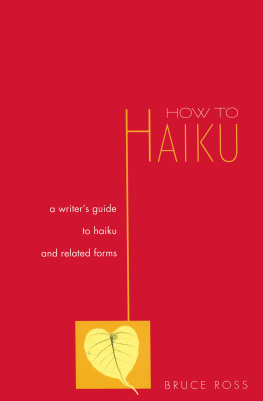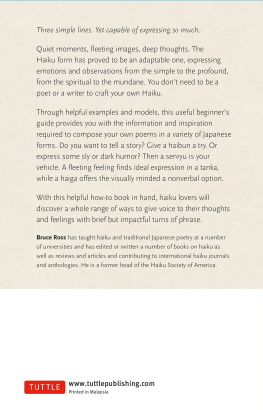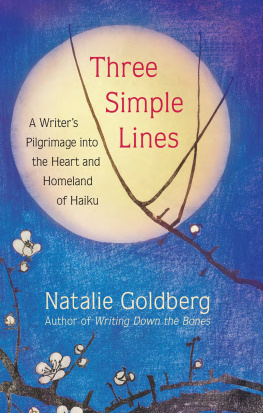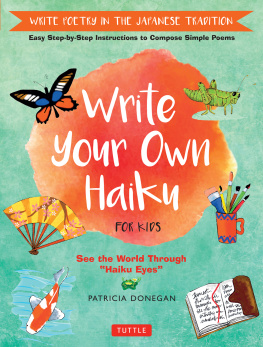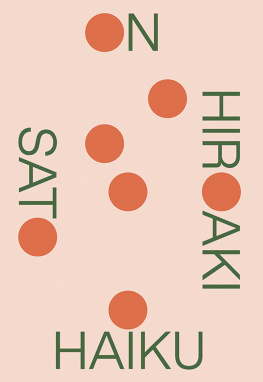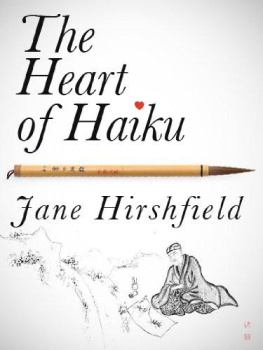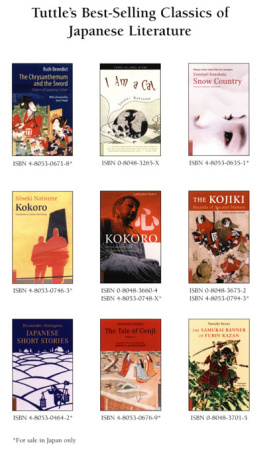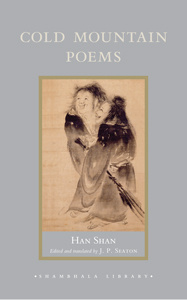Acknowledgments
I would like to thank my students at Writers & Books, Rochester, New York; Writers at Champlain Mill, Winooski, Vermont; the Institute on Japan of the University of Vermont; the Doll-Anstadt Gallery, Burlington, Vermont; and the Japan-America Society of Vermont. Also, the comembers of the Haiku Poets of Upstate New York and the Burlington Haiku Group. And, finally, those haiku poets met in activities sponsored by Haiku Canada, the Haiku Society of America, the Boston Haiku Society, the Kaji Aso Studio, Boston, Massachusetts, and Haiku North America. Thanks for assistance are due to Francine Porad, John Stevenson, and Tomiko Hayashi. Thanks also are due to my editor, Jan Johnson, for nudging me in the right direction. Lastly, and most importantly, Astrid Calypso Miriam Andreescu, my wife; Murray David Ross, my brother; and Tom Clausen, my friend, well deserve very special thanks.
Also by Bruce Ross
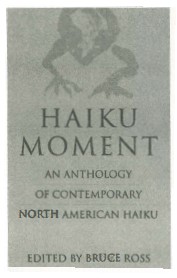
HAIKU MOMENT
An Anthology of Contemporary North American Haiku By Bruce Ross
ISBN 0-8048-1820-7
The most comprehensive volume of contemporary North American haiku written in English, this book features over haiku by poets.
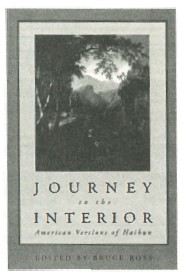
JOURNEY TO THE INTERIOR
American Versions of Haibun By Bruce Ross
ISBN 0-8048-3159-9
Haibun is a beautiful Japanese form of autobiographical poetic prose accompanied by verse, usually haiku. This is the first anthology specifically devoted to original haibun written in English and reflects some of the most moving, personal, and spiritual literature being produced today.
Also available from Tuttle Publishing

JAPANESE HAIKU
By Kenneth Yasuda
ISBN 0-8048-1096-6
The most authoritative and concise book on Japanese haiku available: what it is, how it developed, and how it is practiced in both Japanese and English. One of the few books to combine both translated haiku with haiku written originally in English, this is the perfect book for lovers of poetry who do not have a solid background in haiku.
A BUTTERFLY
A falling flower, thought I,
Fluttering back to the
branch
Was a butterfly.
Moritake from Japanese Haiku
Also available from Tuttle Publishing
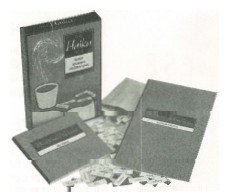
THE HAIKU BOX
By Lonnie Hull DuPont
ISBN 1-58290-030-2
This kit is the first of its kindan attractive package that captures the creative and spiritual power of haiku. It is simple and fun to use, with fifty evocative word tiles and a blank journal. The enclosed book, Footprints in the Snow, provides a fascinating background on haiku, including many masterful examples and over two dozen exercises to awaken the poet within.
Also available from Tuttle Publishing
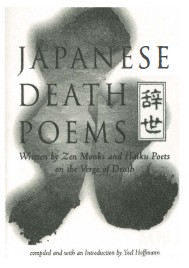
JAPANESE DEATH POEMS
Written by Zen Monks and Haiku Poets on the Verge of Death Compiled and with an Introduction by Yoel Hoffmann
ISBN 0-8048-3179-3
From passionate samurai writings and meditative Zen haiku to the satirical poems of later centuries, hundreds of jisei (death poems) have been translated into English here, many for the first time. The result is a moving, powerful collection whose philosophical and aesthetic profundity will give readers pause.

CLASSIC HAIKU
A Master's Selection
Selected and Translated by Yuzuru Miura
ISBN 0-8048-1682-4
In this wonderful collection, haiku poet Yuzuru Miura has selected and translated poems by past masters such at Basho and Buson, as well as contemporary poets. Fireflies, pheasants, a summer shower, and other beautiful subjects are included among the one hundred poems in this impressive anthology. A revered collection, this book evokes the peace and serenity of the Japanese way of life.
APPENDIX A
Further Notes on Haiku Form
M ODERN AMERICAN HAIKU takes two general forms. One is the "traditional" form. Here, the first line generally connects with a large, more generalized aspect of nature. Line one is usually separated from lines two and three by a punctuation mark, thus setting up a juxtaposition between line one and the concrete image developed in lines two and three. There is often a higher tone in the word choice and phrasing. Also, lines two and three are often almost a grammatically correct sentence in their structure. Consider this example for these elements:
Becoming dusk,
the catfish on the stringer
swims up and down
Robert Spiess
The other general form of modern American haiku is "modern" in its presentation. Here the first line, as in "traditional" haiku, generally connects with a large, more generalized aspect of nature. End punctuation after the first line is, however, usually omitted, although an implicit break is often clearly intended. In this way, a juxtaposition is set up between line one and lines two and three where a concrete image is developed. The biggest difference between the two forms is the manner in which each phrases its lines. In "modern" haiku there is a tendency to organize lines two and three in short, conversational phrasing. A more direct, less formal tone is produced through this phrasing. Look for this tone in the following example:
winter sun
a stranger makes room
without looking
John Stevenson
But, of course, there are many variations on these two basic approaches to haiku form. Some modern American haiku place the generalized connection with nature on the third line and their punctuation at the end of the second line or the beginning of the third line, developing the concrete image in lines one and two. Some haiku imply the connection to broader nature somewhere in the three lines that develop the single image of the given haiku. Here are examples of each:
carrying home
a jar of mint
summer moon
Gloria Procsal
until we stop
the long straight backbone
of the heron
Bruce Ross
There are also many variations to the straight left margin for the three lines of a haiku, with the stair-step indentation in reverse favored by many of the important early American haiku poets, as in the Spiess catfish haiku, being the most common.
A closer look at the ways in which haiku lines are presented on a page might be helpful. Here are two minimalist haiku in which the fewest possible words make up the poem. The first one, by Cor van den Heuvel, may be related to eye-ku in that the single word tundra, which is a treeless expanse of frozen land in the Arctic region, resembles on the page what it means.
tundra sane
a white
moth
Raymond Roseliep
What is gained and what is lost in the second haiku by using only four words to describe a gathering to speak to the dead that is juxtaposed to a white moth?
Many haiku are one-liners. Perhaps their authors are trying to capture the sense in which some Japanese haiku is written in a continuous line. What different effect do these one-liners have as opposed to their being written as typical three-liner haiku?

